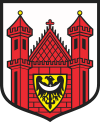Świebodzin
| Świebodzin | |||
|---|---|---|---|

Town hall of Świebodzin
|
|||
|
|||
| Coordinates: 52°15′N 15°32′E / 52.250°N 15.533°ECoordinates: 52°15′N 15°32′E / 52.250°N 15.533°E | |||
| Country |
|
||
| Voivodeship | Lubusz | ||
| County | Świebodzin County | ||
| Gmina | Gmina Świebodzin | ||
| Government | |||
| • Mayor | Dariusz Cezary Bekisz | ||
| Area | |||
| • Total | 10.54 km2 (4.07 sq mi) | ||
| Population (2006) | |||
| • Total | 21,679 | ||
| • Density | 2,100/km2 (5,300/sq mi) | ||
| Time zone | CET (UTC+1) | ||
| • Summer (DST) | CEST (UTC+2) | ||
| Postal code | 66-200 do 66-201 | ||
| Car plates | FSW | ||
| Website | www |
||
Świebodzin [ɕfjɛˈbɔd͡ʑin] (German: Schwiebus) is a town in western Poland with 21,757 inhabitants (2004). It is the capital of Świebodzin County. Since the Local Government Reorganization Act of 1998, Świebodzin has been part of Lubusz Voivodeship. It was formerly part of the Zielona Góra Voivodeship (1975–1998).
Świebodzin was part of the German territory east of the Oder–Neisse line which was annexed by Poland in 1945. Following the annexation, its native German inhabitants were expelled and the city and the surrounding area repopulated by Poles.
Świebodzin is an important transportation hub, lying at the crossroads of the Polish national roads 2 and 3. The A2 motorway and S3 expressway cross near the town. Świebodzin is located 39 km (24 mi) northeast of Zielona Góra, one of the two voivodeship's capitals, 195 km (121 mi) northwest of Wrocław and 110 km (68 mi) west of Poznań; 70 km (43 mi) east of the German border and 130 km (81 mi) east of Berlin. The crowned statue of Christ in Świebodzin, completed in November 2010, is claimed to be the world's tallest statue of Jesus.
The town's name is derived from the Polish personal name Świeboda, related to swoboda meaning "freedom". The earliest historical records which mention Sebusianis, Sipusius Silesius, Suebosian, Soebosian, Suebusianus for today's Świebodzin date from the beginning of the 14th century, when the area belonged to the Lower Silesian duchy of Głogów (German Glogau). The town sprang up at the intersection of the old trade routes linking Silesia with Pomerania and a branch of the route running from Lusatia to Poznań in Greater Poland and further to Pomerelia. Initially, the town was probably a defensive fortification, built on the western banks of Lake Zamecko at a slight elevation. The town wall was ringed by settlements, which were much later incorporated into the city itself.
...
Wikipedia



